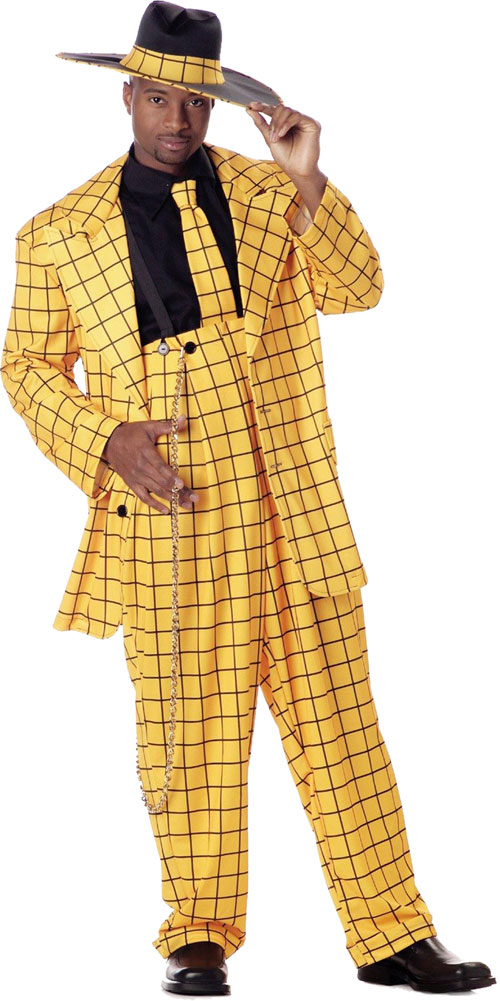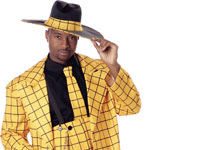Every generation has its own unique fashion in clothes that is not liked by the previous generation. Lately there has been a tendency to “dress down”; the grunge look of the 1980s, or the torn blue jeans of the hippies in the 1960s, but in the 1930s the ultimate in-your-face fashion statement was a suit. It was called a zoot suit and surprisingly, it generated the strongest reaction ever seen about any form of clothing in the modern era.
The zoot suit is a cartoonish exaggeration of the standard business suit. The jacket is large and long, with wide lapels and shoulders padded “like a lunatic’s cell”. The pants are worn very high on the waist; they have large pleats and are very baggy but pegged at the bottom tight to the ankle. That’s because the classic zoot suit wearer would also want to show off his shoes. Often called buck or saddle shoes they typically have very thick soles and two colours of leather. Zoot suit accessories are also important; you need a hat, usually a wide-brimmed fedora – with feathers. Zoot suiters would also have a watch chain that dangled to the knees or below.
The overall effect is much like a stage costume and those of us who were not around in the 1930s know about zoot suits because they were worn on stage by prominent jazz musicians and movie stars, we’ve seen them on film. Cab Calloway wore an exaggerated zoot suit in the movie Stormy Weather.
Modern swing bands still celebrate the zoot suit and they’ve brought about a revival of the style. One band, the Cherry Poppin’ Daddies, released a CD in 1998 featuring the song Zoot Suit Riot that unexpectedly hit the Billboard charts and helped fuel the swing dance craze that year. It sounds like just a fun song but zoot suit riots actually happened and, if you were wearing a zoot suit, they weren’t fun. They represent a very dark period in American and Canadian history, one that isn’t talked about very much these days.
 Zoot suits weren’t the real problem of course; they were a symbol for other, deeper issues. Looking at the history of the suit helps us understand the issues.
Zoot suits weren’t the real problem of course; they were a symbol for other, deeper issues. Looking at the history of the suit helps us understand the issues.
Several tailors take credit for making the first zoot suit but none of them can claim to have invented the style; that came from the street. As in most spontaneous street styles nobody really knows exactly where it started but it’s generally considered to be a Latin-American invention and is closely associated with the pachucos in Los Angeles.
The pachucos are Mexican immigrants who were demonized in the Los Angeles press as hooligans. They wore zoot suits as a badge of honour in the 1930s. Naturally there were tensions but clothing didn’t become an issue until the United States entered the war in December 1941.
In 1942 the War Production Board drew up regulations for the wartime production of suits, their goal was to reduce wool consumption. In Canada, the Wartime Prices and Trade Board had similar guidelines. The regulations effectively forbade the manufacture of zoot-suits and most tailoring companies ceased to make or advertise any suits that fell outside the guide lines. By this time the style had spread well beyond the pachucos, first to young, urban black Americans and then to white, middle-class teenagers in the U.S., Canada and Europe.
That year Life Magazine published photos of teenagers in zoot suits and juke jackets, which is what they called the female version, partying in a swanky Washington club. The story, which ran alongside photos obtained from the German Propaganda Ministry of Canadian soldiers captured in Dieppe, declared the suits to be wasteful and frivolous and “a solid argument for lowering the Army draft age to include 18 year olds”.
The demand for zoot suits did not abate though, underground tailors in New York and Los Angeles continued to make them and the pachucos wore them even more defiantly. They were not protesting the war (Latinos enlisted in large numbers), they were protesting a government telling them what to wear. Unfortunately members of the military did not see it that way.
In June, 1943, after several small altercations involving pachucos and servicemen, large groups of sailors went into Los Angeles looking for zoot-suiters. When they found them, the sailors stripped off their suits and beat them mercilessly. The violence escalated over the next few days and soon there were hundreds of military men from all services roaming the streets looking only for people wearing zoot suits. In one widely-reported incident a group broke into a cinema, pulled a couple of zoot suit wearers on to the stage, stripped them in front of the audience and then urinated on their clothes.
The police were out in full force for the riots; according to the Los Angeles Times they would watch the beatings then arrest the victims. The Times editors were not enraged by this behavior, their editorials treated it a good thing.
The violence spread all across the U.S. over the next few months, often escalating to full-fledged race riots but Canada wasn’t immune. In June of 1944 eerily similar zoot suit riots started in Montreal.
There was a lot of tension between the mostly English-speaking military men stationed there and the French and Italian zoot suit gangs. In June 1944, again after a series of altercations, groups of military men took to the streets of Montreal and neighbouring Verdun stripping and beating anyone, including women, wearing anything resembling a zoot suit. At least here the police, although badly outnumbered, intervened in the attacks and arrested the instigators, not the victims. The military brass did put a stop to the violence more quickly than in Los Angeles but, in a hastily-produced report a few days later, they laid all the blame on the zoot suiters, essentially saying the service men were doing their patriotic duty.
On both sides of the border there were insinuations and investigations into the idea that the whole zoot suit thing was a Nazi plot, designed to cause disharmony and affect our war effort. They didn’t know it at the time but the Nazis had their own zoot suit issues.
In France, which was occupied by the Nazis and had a sympathetic government in the Vichy Regime, laws were also passed which were ultra-conservative and targeted at the youth subculture. The youth of France had become enamoured with American swing music and Cab Calloway in particular in the 1930s. During the Vichy Regime a youth resistance movement, called Zazous after a Cab Calloway song, Zazous Jazz became a major thorn in the side of the Nazis. They wore a modified version of zoot suits to show their defiance against their rulers.
In later times, the mod outfits worn in England by followers of The Who were similar to zoot suits. Even now, the hip hoppers and rappers wear baggy pants and watch chains.
So if you see an old guy today with his pants well up above the waist, don’t laugh. Remember, in his day that was the ultimate act of defiance. Back then it was much more dangerous to wear your pants above the waist than to wear them half way down your butt like their grandchildren do now.

